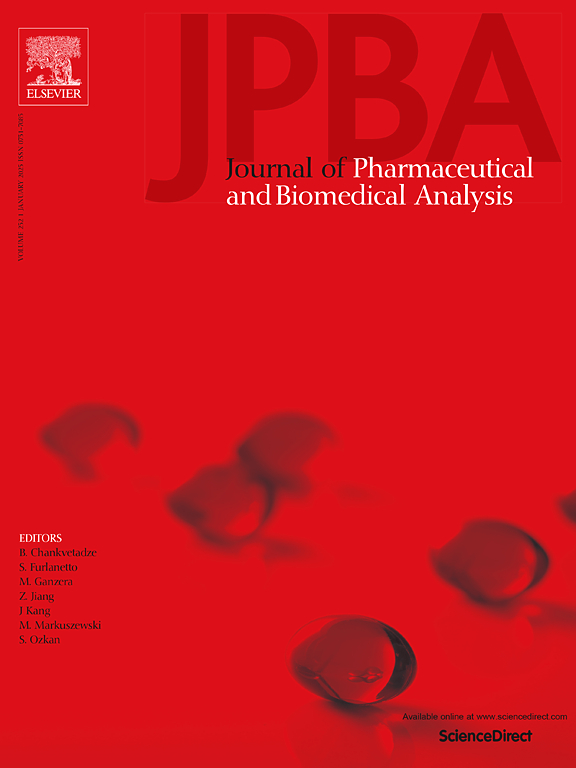Quality evaluation of Citri Reticulatae Pericarpium by supercritical fluid chromatography with chemical pattern recognition
IF 3.1
3区 医学
Q2 CHEMISTRY, ANALYTICAL
Journal of pharmaceutical and biomedical analysis
Pub Date : 2025-04-12
DOI:10.1016/j.jpba.2025.116902
引用次数: 0
Abstract
An efficient and rapid supercritical fluid chromatography (SFC) method was established for the analysis of flavonoids in Citri Reticulatae Pericarpium (CRP), the best conditions were obtained by optimizing the parameters of the SFC method. The peak area obtained by SFC analysis of CRP samples, combined with chemical pattern recognition, was used to establish a model to evaluate the quality of Guang Chenpi (GCP) and Chenpi (CP) in CRP. Partial least squares discriminant analysis (PLS-DA) proved to be an excellent method that can accurately distinguish GCP from CP. The PLS-DA model was established by selecting the training set, and the characteristic components (Didymin and Hesperidin) were screened out to further establish the model, and the testing sets were brought into the model for verification, indicating that the model established based on the peak areas is reliable, and two quality markers (Narirutin and Neohesperidin) were found to distinguish between Xinhui and Non-Xinhui in GCP based on the content determination. In conclusion, the combination of SFC and chemical pattern recognition for the quality evaluation of CRP has great potential.
化学模式识别的超临界流体色谱法评价柑桔皮质量
建立了一种高效、快速的超临界流体色谱(SFC)方法来分析广陈皮(CRP)中的黄酮类化合物,并通过优化SFC方法的参数获得了最佳分析条件。利用 SFC 分析中得到的峰面积,结合化学模式识别,建立了一个模型,用于评价 CRP 中广陈皮(GCP)和陈皮(CP)的质量。事实证明,偏最小二乘判别分析(PLS-DA)是一种能准确区分广陈皮和陈皮的出色方法。通过选择训练集建立 PLS-DA 模型,筛选出特征成分(Didymin 和 Hesperidin)进一步建立模型,并将测试集带入模型进行验证,表明基于峰面积建立的模型是可靠的,并根据含量测定发现了两个质量标记(Narirutin 和 Neohesperidin)可以区分 GCP 中的新会和非新会。总之,将 SFC 与化学模式识别相结合用于 CRP 的质量评价具有很大的潜力。
本文章由计算机程序翻译,如有差异,请以英文原文为准。
求助全文
约1分钟内获得全文
求助全文
来源期刊
CiteScore
6.70
自引率
5.90%
发文量
588
审稿时长
37 days
期刊介绍:
This journal is an international medium directed towards the needs of academic, clinical, government and industrial analysis by publishing original research reports and critical reviews on pharmaceutical and biomedical analysis. It covers the interdisciplinary aspects of analysis in the pharmaceutical, biomedical and clinical sciences, including developments in analytical methodology, instrumentation, computation and interpretation. Submissions on novel applications focusing on drug purity and stability studies, pharmacokinetics, therapeutic monitoring, metabolic profiling; drug-related aspects of analytical biochemistry and forensic toxicology; quality assurance in the pharmaceutical industry are also welcome.
Studies from areas of well established and poorly selective methods, such as UV-VIS spectrophotometry (including derivative and multi-wavelength measurements), basic electroanalytical (potentiometric, polarographic and voltammetric) methods, fluorimetry, flow-injection analysis, etc. are accepted for publication in exceptional cases only, if a unique and substantial advantage over presently known systems is demonstrated. The same applies to the assay of simple drug formulations by any kind of methods and the determination of drugs in biological samples based merely on spiked samples. Drug purity/stability studies should contain information on the structure elucidation of the impurities/degradants.

 求助内容:
求助内容: 应助结果提醒方式:
应助结果提醒方式:


